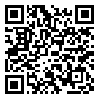BibTeX | RIS | EndNote | Medlars | ProCite | Reference Manager | RefWorks
Send citation to:
URL: http://rjms.iums.ac.ir/article-1-458-en.html
Paraoxonase can hydrolyse organophosphate esters and paraxon is its most important substrate in laboratory studies. This enzyme circulates in blood with HDL. It seems that reduced paraoxonase activity in human may increase risk of coronary artery disease. Genetic variations in two autosomal genes may reduce its activity. These variations produce three phenotypes: A, AB and B. B phenotype activity is higher than A and AB. With regard to high prevalence of CAD in Iranian people and paraoxonase effect in process of CAD, paraoxonase activity, phenotypes and lipid parameters were determined. In this study serum paraoxonase phenotypes in Iranian subjects were determined and the association between paraoxonase activity and its phenotypes with coronary artery disease risk factors were estimated. Patients with more than 50% angiographically confirmed stenosis were studied and compared with healthy subjects at Tehran Rajaii Heart Center. Serum paraoxonase activity with and without NaCl, and arylesterase activity were estimated. Paraoxonase/ Arylesterase activity ratio was used for phenotype determination. In patients, paraoxonase activities with and without NaCl were much lower than healthy subjects (P=0.01 and P=0.00 respectively), but arylesterase activity was not significantly different. Paraoxonase/ arylesterase activity ratio was also reduced in patients (P=0.02). Frequency distributions of three paraoxonase phenotypes in patients and healthy groups were not significantly different. Triglyceride and VLDL-C in patients were higher than healthy subjects (P=0.00), but HDL-C and apo AI were lower in patients (P=0.01 and P=0.00 respectively). No significant variations in total cholesterol, LDL-C and apo B was found in patients compared with healthy group. Due to significant fall in paraoxonase acitivity and no significant difference in frequency distributions of the enzyme phenotypes, it seems that paraoxonase activity measurement in serum is a better marker than determination of the enzyme phenotypes to discriminate patients from healthy subjects.





